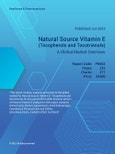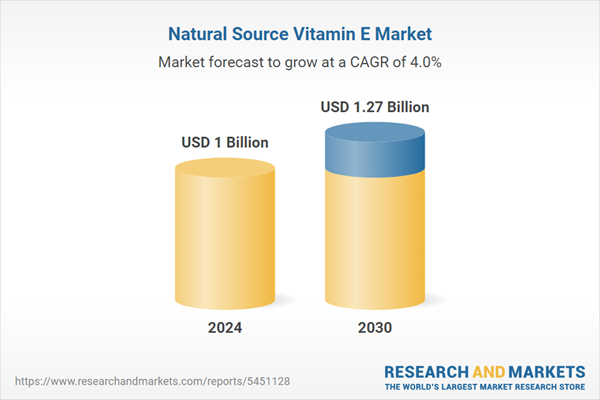The global natural vitamin E market is undergoing a steady evolution, propelled by shifting consumer preferences toward clean-label nutrition, growing interest in natural antioxidants, and tightening regulatory standards in fortified food and nutraceuticals. Derived primarily from vegetable oils, natural vitamin E, comprising tocopherols and tocotrienols, serves as a potent antioxidant with wide-ranging applications in dietary supplements, functional foods, personal care, and animal nutrition. After a brief contraction during 2023-2024 due to destocking and pricing normalization following post-pandemic disruptions, the market has returned to a growth trajectory. In 2024, global demand stood at just over US$1 billion. From this base, the market is expected to reach close to US$1.3 billion by 2030, growing at a compound annual rate of 4% in value.
Demand for natural vitamin E in the dietary supplements industry experienced significant volatility in the aftermath of the COVID-19 pandemic. Following a period of strong growth driven by heightened interest in immunity-boosting formulations, particularly multivitamin combinations containing vitamin E and C, market momentum slowed sharply. In 2022, growth was limited to just 0.6%, and by 2023, global demand contracted by 4.4% in volume terms. The decline was most evident in developed regions, where consumer focus on immune health began to normalize and discretionary spending came under pressure. However, this softness was partially offset by growing interest in other health segments, such as brain and mood support, energy and stamina, and skin health. By 2024, the market began to show early signs of stabilization, as demand for immunity-supporting supplements steadied and broader wellness trends, especially holistic well-being and beauty-from-within, continued to drive interest in natural vitamin E formulations.
Natural vitamin E demand is largely anchored in the dietary supplement segment, with growing contributions from food fortification and skincare innovation. Clean-label positioning and rising consumer focus on immunity and healthy aging are reinforcing its importance across product categories. Meanwhile, tocotrienols, though smaller in share, are gaining visibility for their superior antioxidant efficacy and emerging clinical interest. Looking ahead, differentiated growth patterns are expected to define the global landscape. While tocopherols will continue to dominate by volume, tocotrienols will see faster adoption, especially in high-margin, innovation-driven sectors. Supported by favorable regulatory environments and shifting health-conscious lifestyles, the natural vitamin E market is well-positioned for long-term expansion across both developed and emerging economies.
Base Year: 2024
Forecast Period: 2024-2030
Units: Volume in Metric Tons and Value market in US$
Companies Mentioned: 38
This product will be delivered within 2-4 business days.
Demand for natural vitamin E in the dietary supplements industry experienced significant volatility in the aftermath of the COVID-19 pandemic. Following a period of strong growth driven by heightened interest in immunity-boosting formulations, particularly multivitamin combinations containing vitamin E and C, market momentum slowed sharply. In 2022, growth was limited to just 0.6%, and by 2023, global demand contracted by 4.4% in volume terms. The decline was most evident in developed regions, where consumer focus on immune health began to normalize and discretionary spending came under pressure. However, this softness was partially offset by growing interest in other health segments, such as brain and mood support, energy and stamina, and skin health. By 2024, the market began to show early signs of stabilization, as demand for immunity-supporting supplements steadied and broader wellness trends, especially holistic well-being and beauty-from-within, continued to drive interest in natural vitamin E formulations.
Natural vitamin E demand is largely anchored in the dietary supplement segment, with growing contributions from food fortification and skincare innovation. Clean-label positioning and rising consumer focus on immunity and healthy aging are reinforcing its importance across product categories. Meanwhile, tocotrienols, though smaller in share, are gaining visibility for their superior antioxidant efficacy and emerging clinical interest. Looking ahead, differentiated growth patterns are expected to define the global landscape. While tocopherols will continue to dominate by volume, tocotrienols will see faster adoption, especially in high-margin, innovation-driven sectors. Supported by favorable regulatory environments and shifting health-conscious lifestyles, the natural vitamin E market is well-positioned for long-term expansion across both developed and emerging economies.
Natural Source Vitamin E Regional Market Analysis
Between 2021 and 2024, the natural vitamin E market showed modest growth across most regions, impacted by inflation, high raw material costs, and post-pandemic demand correction. Asia-Pacific leads both in volume market share (36.4% in 2024) and growth rate, expanding at a CAGR of 5.2% between 2024 and 2030, driven by strong demand in dietary supplements and functional foods, particularly in China, India, and Southeast Asia. North America and Europe, though mature markets, are forecast to grow at more modest rates, supported by stable demand in health supplements and personal care. South America and the Rest of the World are emerging as growth frontiers. These regions are benefitting from expanding fortified food markets, increasing awareness about clean-label nutrition, and growing adoption of tocotrienols in cosmetics and wellness applications.Natural Source Vitamin E Market Analysis by Type
Tocopherols continue to represent the dominant share of global natural vitamin E consumption, which cornered a share of 98.7% in 2024 and projected to progress at a CAGR of 3.7% over 2024-2030 outlook period. Their widespread use across dietary supplements, fortified foods, cosmetics, and animal feed underpins their leadership position in the market. While much smaller in scale, tocotrienols are gaining momentum as the fastest-growing type, expanding at an impressive CAGR of 6.4%. Growth is being fueled by their emerging applications in neuroprotection, cardiovascular health, and anti-inflammatory formulations, particularly in the high-value nutraceuticals segment.Natural Source Vitamin E Market Analysis by End-use Application
In 2024, dietary supplements stood out as the dominant application in the global natural vitamin E market, accounting for approximately 61% of total volume. This segment is expected to maintain its lead through 2030, expanding at a CAGR of 3.5% and reaching nearly 11.8 thousand metric tons. The growth is primarily driven by consumers' increasing inclination toward preventive health, natural immunity boosters, and plant-derived antioxidants. Food & beverages, the second-largest segment, is growing at a faster 4.4% CAGR, supported by expanding fortification regulations and rising demand for functional foods in Asia-Pacific and emerging markets. Meanwhile, cosmetics & personal care applications are also witnessing healthy expansion. This growth is fueled by increased use of tocotrienol-rich formulations in anti-aging, skin-brightening, and antioxidant skincare products.Natural Source Vitamin E Market Report Scope
This global report on Natural Source Vitamin E analyzes the global and regional market based on product types and end-use applications for the period 2021-2030 with projection from 2024 to 2030 in terms of volume in metric tons and value in US$. In addition to providing profiles of major companies operating in this space, the latest corporate and industrial developments have been covered to offer a clear panorama of how and where the market is progressing. The report also reveals latest production capacities of all players by plant location and region.Key Metrics
Historical Period: 2021-2023Base Year: 2024
Forecast Period: 2024-2030
Units: Volume in Metric Tons and Value market in US$
Companies Mentioned: 38
Natural Source Vitamin E Market by Geographic Region
- North America (The United States, Canada and Mexico)
- Europe (Germany, France, Italy, Spain, the Netherlands, the United Kingdom, and Rest of Europe)
- Asia-Pacific (China, Japan, India, and Rest of Asia-Pacific)
- South America (Brazil, Argentina, and Rest of South America)
- Rest of World
Natural Source Vitamin E Market by Type
- Tocopherols
- Tocotrienols
Natural Source Vitamin E Market by Application
- Animal Feed
- Dietary Supplements
- Food & Beverages
- Cosmetics
- Others (including pharmaceuticals, medical nutrition, and infant nutrition)
This product will be delivered within 2-4 business days.
Table of Contents
PART A: GLOBAL MARKET PERSPECTIVE
1. INTRODUCTION
2. REGULATIONS FOR DIETARY SUPPLEMENTS AND INGREDIENTS
3. INDUSTRY LANDSCAPE
4. KEY BUSINESS TRENDS
5. GLOBAL MARKET OVERVIEW
PART B: REGIONAL MARKET PERSPECTIVE
6. NORTH AMERICA
7. EUROPE
8. ASIA-PACIFIC
9. SOUTH AMERICA
10. REST OF WORLD
PART C: GUIDE TO THE INDUSTRY
PART D: ANNEXURE
Companies Mentioned
- American River Nutrition, Inc.
- Archer Daniels Midland Company
- Beijing Gingko Group
- BTSA Biotecnologias Aplicadas SL
- COFCO Biotechnology Co., Ltd.
- DSM-Firmenich
- ExcelVite Sdn. Bhd.
- Fujian Glanny Bio-Engineering Co., Ltd.
- Jiangsu Conat Biological Products Co., Ltd.
- Kensing, LLC. (AOM S.A. & Vitae Naturals S.A.)
- KLK Oleo (Davos Life Science)
- Matrix Life Science Pvt. Ltd.
- Mitsubishi-Chemical Foods Corporation
- Vance Group Ltd.
- Wilmar International Limited
- Xi'an Healthful Biotechnology Co Ltd (HSF)
- Zhejiang Medicine Co Ltd
- Zhejiang Worldbestve Biotechnology Co Ltd
Table Information
| Report Attribute | Details |
|---|---|
| No. of Pages | 413 |
| Published | July 2025 |
| Forecast Period | 2024 - 2030 |
| Estimated Market Value ( USD | $ 1 Billion |
| Forecasted Market Value ( USD | $ 1.27 Billion |
| Compound Annual Growth Rate | 4.0% |
| Regions Covered | Global |
| No. of Companies Mentioned | 18 |









